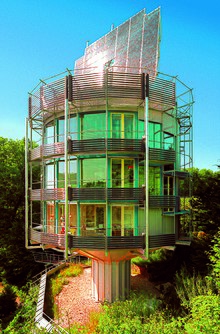This is an old revision of this page, as edited by Martin Valeria (talk | contribs) at 06:19, 31 March 2023. The present address (URL) is a permanent link to this revision, which may differ significantly from the current revision.
Revision as of 06:19, 31 March 2023 by Martin Valeria (talk | contribs)(diff) ← Previous revision | Latest revision (diff) | Newer revision → (diff)This article has multiple issues. Please help improve it or discuss these issues on the talk page. (Learn how and when to remove these messages)
|

The Heliotrope is a design of environmentally friendly housing by German architect Rolf Disch. Three such buildings exist in Germany; the first experimental version was built in 1994 as the architect's home in Freiburg im Breisgau, while the other two were used as exhibition buildings for the Hansgrohe company in Offenburg and a dentist's lab in Hilpoltstein in Bavaria.
Several different energy generation modules are used in the building including a 603 sq ft (56.0 m) dual-axis solar photovoltaic tracking panel, a geothermal heat exchanger, a combined heat and power unit (CHP) and solar-thermal balcony railings to provide heat and warm water. These innovations along with the favorable insulation of the residence allows the Heliotrope to capture anywhere between four and six times its energy usage depending on the time of year. The Heliotrope is also fitted with a grey-water cleansing system and built-in natural waste composting.
At the same time that Freiburg ’s Heliotrope was built, Hansgrohe contracted Disch's architecture practice to design and build another Heliotrope to be used as a visitor’s center and showroom in Offenburg, Germany. A third one was then contracted and built in Hilpoltstein, Bavaria to be used as a technical dental laboratory. Disch's unique design accommodates different utilizations from private residences to laboratories, and nevertheless maintains the structure's positive energy balance.
 Heliotrop Rotating House
Heliotrop Rotating House Bird's eye view of the Heliotrope in Freiburg
Bird's eye view of the Heliotrope in Freiburg Heliotrope-Hotel Schloss Waretenstein
Heliotrope-Hotel Schloss Waretenstein
Disch also designed the Sonnenschiff office complex.
PlusEnergy
PlusEnergy is a concept coined by Rolf Disch that indicates a structure's energy efficiency. A PlusEnergy building holds a positive energy balance, generating more energy than it uses. With the completion of his private residence, the Heliotrope, in 1994, Disch had created the first PlusEnergy house in the world. The idea of a home that captures more energy than it consumes made perfect sense to him. His next goal in its development then, was the mass adoption of the concept to residential, commercial and retail space. As the concept further developed and gained financial backing, Disch built several more projects with PlusEnergy certifications. “PlusEnergy is a fundamental environmental imperative,” Disch claims. Disch believes that passive building is not enough because passive homes still emit CO2 into the atmosphere.
Environment and energy needs
The house is designed to face the sun with its triple-pane windows (U = 0.5) during the heating months of the year and turn its highly insulated back (U = 0.12) to the sun during the warmer months when heating isn't necessary. This significantly reduces heating and cooling requirements for the building throughout the year, which are provided for by a heat pump, while hot water is provided by vacuum-tube solar panels.
Photovoltaic solar panels with a rated power of 6.6 kW on its roof provide five to six times more energy than the building uses, making the building "energy positive" (PlusEnergy). To further improve energy generation, the panels also rotate independently of the building to follow the sun, while being able to adapt its orientation in case of strong winds.
Water usage and natural waste management
In order to limit water usage, a gray water circuit (for washing dishes and clothes) is used. It also collects rainwater. Wastewater is purified in a vegetated cascade pond outside the edifice.
Natural waste and excrement are dry composted in the structure as well.
Inhabitant comfort
| This section does not cite any sources. Please help improve this section by adding citations to reliable sources. Unsourced material may be challenged and removed. (December 2022) (Learn how and when to remove this message) |
One of the main attractions of the house, apart from its low energy needs, is its rotating view. As the building turns according to the sun's position, the view changes. This feature was later developed into a rotating hotel concept.
The roof deck includes a sun and viewing deck, as well as a garden terrace. The solar panels can be used for sun or rain protection while on the roof terrace.
All floors are accessible from the spiral staircase, reducing surface loss through hallways and corridors.
Awards
- 2008 German Sustainability Award
- 2007–08 Japanese PEN-Magazine Creativity Award
- 2005 Wuppertal Energy and Environment Prize
- 2003 Global Energy Award
- 2002 European Solar Prize
- 2001 Photovoltaic Architecture Prize Baden-Württemberg
Selected works
| This article needs additional citations for verification. Please help improve this article by adding citations to reliable sources. Unsourced material may be challenged and removed. Find sources: "Heliotrope" building – news · newspapers · books · scholar · JSTOR (July 2022) (Learn how and when to remove this message) |
- Heliotrope, Vauban, Freiburg, 1994
- Heliotrope, Offenburg, 1994
- Heliotrope, Hilpoltstein, 1995
-
 Heliotrope in Vauban, Freiburg, 1994
Heliotrope in Vauban, Freiburg, 1994
-
 Heliotrope built for Hansgrohe in Offenburg, 1994
Heliotrope built for Hansgrohe in Offenburg, 1994
See also
- Sustainable architecture
- Sun Ship
- Solar Settlement
- Energy-plus-house
- Passive solar design
- Anti-nuclear movement in Germany
- Green building
- Zero-energy building
- Villa Girasole
Notes
- "Home". rolfdisch.de.
External links
- Official website of the Heliotrop (in English)
- Freshome.com: brief description with pictures (archived 2014)
- Article in Chinese with some pictures of the house (in Chinese)
- Solar Settlement and Sun Ship Video
- PlusEnergy (archived 2014)